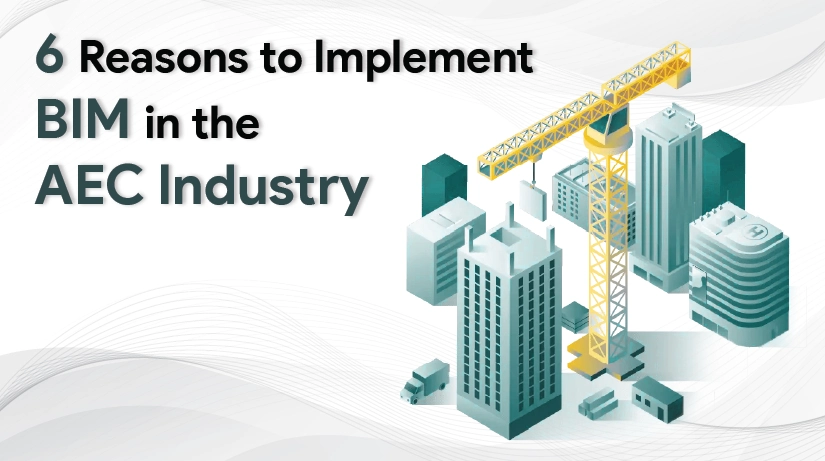6 Reasons to Implement BIM in the AEC Industry
Mar 27, 2023
Category: Industry Trends
Admin

In the dynamic landscape of the Architecture, Engineering, and Construction (AEC) industry, staying ahead is not just a matter of speed but also efficiency. Building Information Modeling (BIM) has emerged as a transformative technology, reshaping the way projects are conceptualized, designed, and executed.
The fast-paced AEC industry is harnessing innovative technologies is pivotal. Building Information Modeling (BIM) stands at the forefront, revolutionizing project workflows. This article explores the facets of BIM, elucidates its significance, and presents six compelling reasons why its implementation is crucial in the AEC industry.
BIM: An Intro
Before delving into the reasons, let’s understand what BIM is. BIM is not just software; it’s a collaborative process, that integrates digital information for efficient planning, designing, constructing, and managing buildings and infrastructure. Building Information Modeling is one of the most essential designing tools used in the construction industry for more than just collaboration.
| Dive Deeper: Understanding BIM (Building Information Modelling)
BIM creates a 3D model that encompasses geometry, spatial relationships, geographic information, and quantities. This model serves as a shared knowledge resource for information about a facility, forming a reliable basis for decisions throughout its lifecycle. The implementation of BIM can save time and money, and provide realistic models at every step of a project’s lifecycle.
Reasons to Implement BIM In the AEC Industry
1. Enhanced Collaboration
BIM fosters collaboration among stakeholders by providing a centralized platform for real-time data sharing. Architects, engineers, contractors, and other project participants can concurrently work on the same model, reducing the risk of errors and ensuring that everyone is on the same page. It helps in faster and more efficient work.
The collaborative approach streamlines communication, leading to more accurate and timely decision-making, ultimately improving project outcomes. Different tools and functionalities, a large number of which can be accessed from the cloud, offer an advantageous approach that would basically not be possible utilizing paper or even separate digital systems.
2. Improved Visualization
One of BIM’s standout features is its ability to create a 3D model that offers a realistic visualization of the project. It helps in identifying potential issues before they become costly problems during construction. Clients can visualize the end product more comprehensively, making it easier to convey design intent and obtain feedback early in the process.
The visualization in BIM helps engineers to get a much better understanding of the project at hand. This improvised understanding paves the path to increased productivity and a more efficient planning process. Also, with accurate visualizations, BIM can help you avoid potential problems and increase safety.
3. Efficient Design and Planning
BIM helps architects and engineers to simulate and analyze various design scenarios, assessing factors like structural integrity, energy efficiency, and cost implications, resulting in optimized designs, that meet both aesthetic and functional requirements. The ability to identify and resolve potential issues before construction begins contributes to a smoother project timeline.
The 3D model of the construction project provided by BIM can be shared among all team members. This results in more efficient use of resources and leads to fewer change orders. In fact, BIM is capable of creating more prefabricated and boltable components, further reducing construction costs.
4. Cost Savings
Implementing BIM can lead to substantial cost savings throughout the project lifecycle. By identifying clashes and issues in the virtual model, rework and construction delays are minimized. Accurate quantity take-offs and cost estimations can be derived directly from the BIM model, preventing costly discrepancies between the budget and the actual construction costs.
The predictive capabilities of BIM contribute to more accurate project cost forecasting. The BIM technology estimates a reasonable total price which is based on the specific expenses required for each part of the entire project quantity, unlike traditional project cost management which shows an estimated price by referring to previous practical cases or experience.
5. Lifecycle Management
BIM goes beyond the construction phase, as it extends its benefits throughout the lifecycle of a building or infrastructure. The data-rich BIM model serves as a valuable resource for facility management, enabling owners and operators to efficiently manage and maintain assets. It helps in maximizing the lifespan and value of the facility.
From tracking maintenance schedules to facilitating renovations, BIM ensures that the information remains up-to-date and accessible and estimates a reasonable total price which is based on the specific expenses required for each part of the entire project quantity, unlike traditional project cost management, showing estimated prices by referring to previous practical cases or experience.
6. Regulatory Compliance and Documentation
In the AEC industry, adherence to regulations and documentation requirements is paramount. BIM aids in maintaining compliance by providing a comprehensive and organized repository of project information. This not only streamlines the documentation process but also facilitates easier audits and inspections.
Professionals can track and verify compliance throughout the project lifecycle, by digitally documenting the relevant building code requirements in the BIM model, ensuring that all building code obligations are met, and providing an auditable record for future reference.
| Also Read: BIM Impacting Structural and Civil Engineering Operations
Conclusion
In conclusion, the implementation of BIM in the AEC (Architecture, Engineering, and Construction) industry is indeed a paradigm shift. The enhanced collaboration, improved visualization, efficient design and planning, cost savings, lifecycle management, and regulatory compliance offered by BIM collectively contribute to a more streamlined and successful project delivery.
As the AEC industry continues to evolve, embracing BIM becomes not only a competitive advantage but a necessity. The holistic approach of BIM, encompassing the entire lifecycle of a project, sets the stage for a future where construction projects are not just built but meticulously crafted with efficiency, precision, and sustainability.
About TechnoStruct Academy
TechnoStruct Academy is the educational arm of TechnoStruct, LLC, a registered design engineering firm based in California. It offers specialized BIM training programs for architecture, MEP, and BIM Management.
Our BIM Certification Courses
BIM-Ready Architecture Advanced
BIM-Ready Complete 2.0 (Michigan State University)








